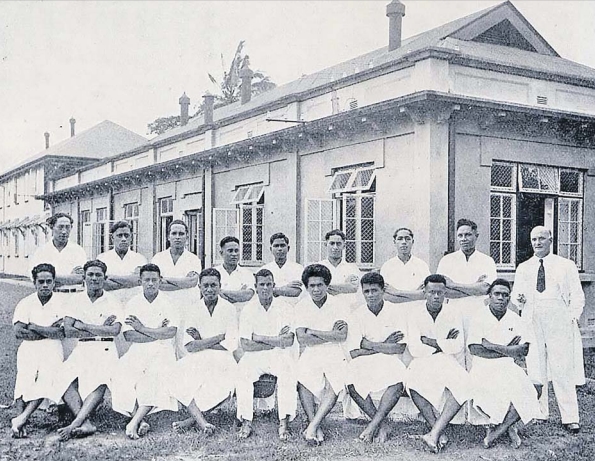Fiji became a British colony in 1874, driven largely by economic struggles. The situation deteriorated in 1875 when Ratu Cakobau and his party returned from Sydney carrying measles. The epidemic devastated the non-immune Fijian population, killing an estimated 30 per cent. Unlike the Hawaiian experience of victims fleeing into the sea, pneumonia resulting from lying under trees was a leading cause of death in Fiji.
In response to labour shortages caused by the epidemic, the British brought indentured Indian workers beginning in 1879. These immigrants, arriving amid smallpox and cholera outbreaks, were quarantined upon landing in Levuka. Fijian men were trained by the chief medical officer as public vaccinators, who reported dire health conditions. Their effectiveness led to a proposal for formal medical training, which was initially rejected by the Colonial Office but later approved in 1885.
By 1886, six Fijians began training at Suva Hospital. Three graduated in 1888: Ratu Fereteriki Temesia (Bau), Jemesa Tunakece (Ra) and Ratu William Uqueqe (Bua), followed shortly by Laisiasa Cadri (Kadavu). Between 1888 and 1897, 26 Fijians qualified as Native Practitioners (NPs). Despite limitations in English and scientific education, these practitioners were well-prepared for frontline rural healthcare.
In 1912, the first Rotuman, Jotama Tigarea, graduated. The first Tokelau students followed in 1916. Due to the Tokelaus’ remoteness from administrative centres, Suva-trained practitioners were essential. New Zealand later depended on Samoan graduates for Tokelau’s medical posts, with some Tokelauan doctors emerging by 1953.
American physician Dr S.M. Lambert of the Rockefeller Foundation, touring the South Pacific in the 1920s, praised Fiji’s public health achievements and its Suva Medical School. Initially skeptical, the foundation later funded a new building, now the Suva Dental Clinic. In return, Fiji agreed to routinely admit overseas students and extend training from three to four years. Mr (later Dr) Hoodless was appointed as the school’s first full-time principal.
The school – by then informally referred to as the Central Medical School – trained students from Western Samoa (first graduate in 1927), the Gilbert Islands (1928), Solomon Islands (1930), Tonga and the Cook Islands (1931). The final class under the three-year system graduated in 1933, totaling 168 students.
More countries joined over time: Nauru and American Samoa (1938), New Hebrides (1943), Niue (1950), Papua New Guinea and US Trust Territories (1951). Entry standards rose with Fiji’s educational improvements, moving to English-only instruction in the 1920s. By the 1950s, two years of secondary education were required; by 1952, Form V education was standard.
By 1955, the course extended to five years. However, attempts to run both four- and five-year courses failed due to staffing shortages. From 1934 to 1955, 264 students graduated from the four-year program. Challenges included overseas students’ lower educational backgrounds and a shortage of pre-clinical instructors. A pre-entry class addressed the first issue until 1968 when the University of the South Pacific (USP) assumed control of the first-year program. WHO helped resolve staffing gaps by providing lecturers in physiology, biochemistry, and biology, while Fiji recruited instructors in English, math, and sciences.
In 1954, UK Commonwealth funds allowed the school’s relocation to Tamavua, though its distance from the teaching hospital (Colonial War Memorial Hospital, CWMH) posed logistical issues. The Nuffield Foundation funded a Department of Social and Preventive Medicine in 1959. Additional departments – Hygiene (1961), Nutrition and Dietetics (1966) – followed. In 1967, a 30-bed student hostel and teaching unit named Hoodless House opened near CWMH.
The school was officially renamed the Fiji School of Medicine (FSM) in 1961. VIth Form education became mandatory, and overseas students with New Zealand University Entrance qualifications began entering directly into the second year. A curriculum comparison with Otago (New Zealand) showed similar upper-level structures but gaps in Fiji’s pre-clinical foundation, limiting FSM graduates’ postgraduate options. Indian medical schools addressed this with two-year condensed MBBS programs for select FSM alumni.
In 1970, the USP Council initiated a Commission on Medical and Dental Education to explore incorporating FSM into the university and elevating its diploma to a degree. A conversion course for diploma holders was also considered.
In 1945, FSM introduced dental training. Over the years, it expanded to include programs for health inspectors, dietitians, lab and radiography technicians, physiotherapists, dental hygienists, and pharmacists. A public health course ran from 1960 to 1968 to retrain senior FSM graduates.
By March 1971, 151 students had completed the five-year medical program. Annual graduates averaged ten, but the class size was expected to grow. The CWMH, with 288 beds, served as the primary teaching hospital. However, expansion of student intake required participation from Lautoka Hospital. At the time, 10 full-time staff and 13 specialist doctors were involved in teaching.
The Fiji School of Medicine began as an unconventional approach to medical education. Once questioned, it is now recognized as a critical institution in delivering healthcare to developing Pacific nations.
The medical school underwent three name changes. It was known as the Suva Medical School from 1885 to 1928, the Central Medical School from 1929 to 1960 and the Fiji School of Medicine from 1961 to the Fiji National University’s College of Medicine, Nursing and Health Sciences from 2010.



